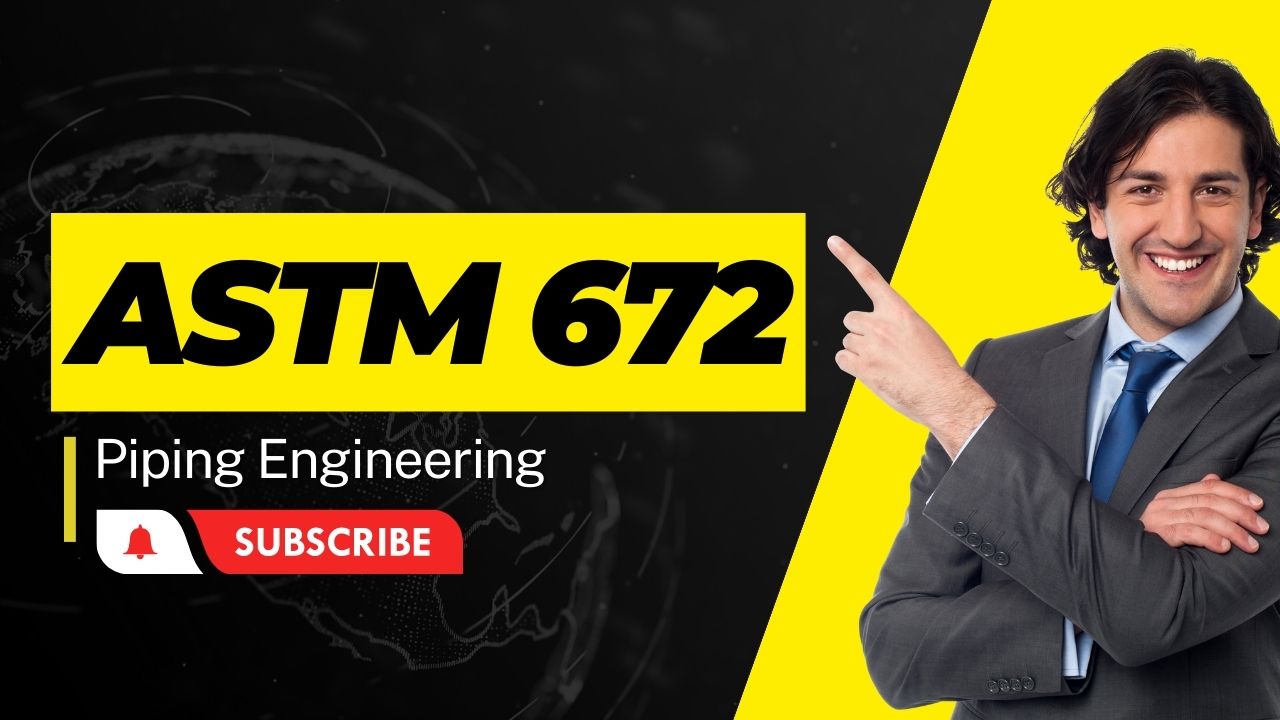1. Introduction
Carbon steel pipes are essential components in various industries, serving as conduits for fluids, gases, and solids. ASTM 672, a standard for electric-fusion-welded steel pipes with filler metal added, plays a pivotal role in ensuring the quality and performance of carbon steel pipes.
Do not miss the detailed course 7 Modules of Piping Codes & Standards
Enrollment link
Check out the Similar Articles on ASTM Standards
Importance of Carbon Steel Pipes
Carbon steel pipes are renowned for their strength, durability, and cost-effectiveness, making them a preferred choice in applications ranging from water distribution to petrochemical processing.
Role of ASTM Standards
The American Society for Testing and Materials (ASTM) establishes standards to guarantee the reliability and consistency of materials used in diverse industries. ASTM A672 sets the benchmark for electric-fusion-welded carbon steel pipes, facilitating safe and efficient transportation of various substances.
2. Various Grades of ASTM 672
ASTM A672 encompasses a range of grades, each tailored to specific applications.
Differentiation Based on Composition and Intended Use
Grades within ASTM 672 vary primarily in their chemical composition, which influences their mechanical properties and suitability for particular environments.
Comparison of Key Properties (Table)
| Grade | Carbon Content (%) | Tensile Strength (MPa) | Impact Test Temperature (°C) |
|---|---|---|---|
| A45 | 0.17 max | 310 min | -50 |
| A50 | 0.22 max | 345 min | -50 |
| A55 | 0.28 max | 380 min | -50 |
| A60 | 0.32 max | 415 min | -50 |
Do not miss the detailed course 7 Modules of Piping Codes & Standards
Enrollment link
3. Chemical Composition
The chemical composition of ASTM 672 carbon steel pipes significantly influences their mechanical and chemical properties.
Elemental Influence on Material Properties
- Carbon (C): Affects hardness and strength.
- Silicon (Si): Enhances high-temperature resistance.
- Manganese (Mn): Contributes to strength and weldability.
- Phosphorus (P) and Sulfur (S): Affect material brittleness.
Chemical Composition for Different Grades (in %)
| Element | A45 | A50 | A55 | A60 |
|---|---|---|---|---|
| Carbon (C) | 0.17 | 0.22 | 0.28 | 0.32 |
| Silicon (Si) | 0.98 | 0.98 | 0.98 | 0.98 |
| Manganese (Mn) | 1.65 | 1.65 | 1.65 | 1.65 |
| Phosphorus (P) | 0.025 | 0.025 | 0.025 | 0.025 |
| Sulfur (S) | 0.025 | 0.025 | 0.025 | 0.025 |
4. Mechanical & Chemical Properties
Understanding the mechanical and chemical properties of ASTM A672 carbon steel pipes is crucial for selecting the right grade.
Mechanical Properties
- Tensile Strength: The maximum stress a material can withstand while being stretched.
- Yield Strength: The stress at which permanent deformation begins.
- Impact Test Temperature: The temperature at which the material retains its toughness.
Chemical Properties
- Corrosion Resistance: The ability to withstand chemical corrosion.
- Weldability: Ease of welding without compromising material properties.
| Property | A45 | A50 | A55 | A60 |
|---|---|---|---|---|
| Tensile Strength (MPa) | 310 min | 345 min | 380 min | 415 min |
| Yield Strength (MPa) | 220 min | 240 min | 275 min | 305 min |
| Impact Test Temperature (°C) | -50 | -50 | -50 | -50 |
| Corrosion Resistance | Excellent | Excellent | Excellent | Excellent |
| Weldability | Good | Good | Good | Good |
5. Manufacturing Process
Understanding the manufacturing process of ASTM 672 carbon steel pipes is crucial for ensuring their quality and performance.
Step-by-step Explanation
- Plate Preparation: High-quality steel plates are cut, shaped, and prepared for welding.
- Welding: Electric-fusion welding with filler metal is employed to join the plates.
- Heat Treatment: Pipes undergo heat treatment to improve their mechanical properties.
- Inspection: Rigorous inspection, including non-destructive tests, ensures the quality of the pipes.
- Finishing: Pipes are cut, threaded, and surface-finished as needed.
Emphasis on Controlled Processes
Precise control over welding parameters and heat treatment is crucial for achieving the desired material properties.
Do not miss the detailed course 7 Modules of Piping Codes & Standards
Enrollment link
6. Pros & Cons of ASTM 672
As with any material, ASTM 672 carbon steel pipes come with their set of advantages and limitations.
Advantages
- Cost-effective compared to some alternatives.
- Suitable for high-pressure and high-temperature applications.
- Variety of grades catering to different requirements.
Limitations
- Lower corrosion resistance compared to stainless steel.
- May require additional corrosion protection in aggressive environments.
- Proper welding procedures are essential to prevent brittleness.
7. Applications of ASTM 672
The mechanical and chemical properties of ASTM 672 carbon steel pipes make them indispensable in various industries.
Wide Range of Industries
- Power Generation: Used in boilers, superheaters, and condensers.
- Oil and Gas: Transporting oil, gas, and related products.
- Chemical Processing: Handling corrosive chemicals and fluids.
- Construction: Structural applications where strength is paramount.
Key Properties for Applications
- High tensile strength for pressure applications.
- Impact resistance for low-temperature environments.
8. Codes & Standards
ASTM 672 carbon steel pipes adhere to various codes and standards to ensure safety and quality.
Adherence to Codes
- ASME Boiler and Pressure Vessel Code: Specifies materials for pressure vessels.
- ASTM A672/A672M: Standard specification for electric-fusion-welded steel pipe.
- API 5L: Specifies line pipe materials for the oil and gas industry.
Industries Relying on Standards
Industries such as power generation, oil and gas, petrochemical, and construction adhere to these standards for material selection and design.
Do not miss the detailed course 7 Modules of Piping Codes & Standards
Enrollment link
9. Quality Control & Testing
The manufacturing of ASTM 672 carbon steel pipes involves stringent quality control measures.
Ensuring Material Integrity
Quality control and testing are crucial in ensuring the safety and reliability of ASTM 672 carbon steel pipes.
- Chemical Analysis: Rigorous chemical analysis is performed to verify the elemental composition of the pipes. This ensures that the carbon steel meets the specified standards and grades.
- Mechanical Testing: Mechanical testing, including tensile and yield strength tests, is conducted to assess the pipes’ mechanical properties. These tests verify that the pipes can withstand the required stresses and pressures in their intended applications.
- Non-Destructive Testing: Non-destructive testing methods such as ultrasonic testing and radiographic testing are employed to detect surface and internal defects in the pipes. These tests are crucial for identifying any flaws that could compromise the pipes’ structural integrity.
- Microstructural Examination: Microstructural examination involves analyzing the internal structure of the pipes under a microscope. This examination helps assess the material’s grain size, phase composition, and any potential defects that may affect its performance.
10. Standards & Certificates
ASTM 672 materials are accompanied by various certificates that attest to their quality and compliance.
Importance of Certificates
Certificates play a vital role in ensuring the traceability and quality of ASTM 672 carbon steel pipes.
- Mill Test Certificate: The Mill Test Certificate provides detailed information about the pipes, including their chemical composition, mechanical properties, and compliance with ASTM standards. It serves as a critical document for verifying the quality of the pipes.
- ISO Certification: ISO certification demonstrates that the manufacturer follows international quality management standards. It signifies a commitment to quality control and adherence to best practices in manufacturing.
11. Ordering Information
Precise ordering information ensures the receipt of the desired ASTM 672 carbon steel pipes.
Essential Information
When ordering ASTM 672 carbon steel pipes, it is essential to provide accurate information to meet specific project requirements:
- Grade: Specify the appropriate grade (e.g., A45, A50) that aligns with the intended use and application of the pipes.
- Size: Indicate the dimensions, including diameter, wall thickness, and length, of the required pipes. Accurate sizing is crucial for compatibility with existing systems and structures.
- Quantity: Clearly state the quantity of pipes needed to fulfill project requirements. This ensures that an adequate supply is available for the project’s duration.
- Additional Requirements: Highlight any specific requirements, such as surface finish, special coatings, or additional testing, to meet project specifications. These details ensure that the pipes meet all project-specific needs.
Supplementary Testing Requirements
In addition to the standard quality control and testing procedures, some projects may require supplementary testing based on specific industry or application requirements. These supplementary tests may include:
- Hydrostatic Testing: Hydrostatic testing involves subjecting the pipes to high-pressure water to check for leaks or weaknesses. It ensures that the pipes can withstand the pressures they will encounter in their intended applications.
- Charpy Impact Testing: Charpy impact testing assesses the pipes’ resistance to low-temperature brittleness. It is particularly important for applications where the pipes will be exposed to sub-zero temperatures.
- Ultrasonic Testing: Ultrasonic testing is used to detect internal defects and assess the integrity of welds in the pipes. It provides a more detailed examination of the pipes’ internal structure.
- Corrosion Testing: Corrosion testing evaluates the pipes’ resistance to corrosion from specific chemicals or environments. It is essential in industries where corrosion can compromise safety and performance.
These supplementary tests ensure that ASTM 672 carbon steel pipes meet the unique requirements of specific projects or applications, providing an extra layer of quality assurance.
Do not miss the detailed course 7 Modules of Piping Codes & Standards
Enrollment link
12. Comparison with Other ASTM Standards
A comparison of ASTM 672 with related standards helps in material selection.
Comparative Analysis
| Parameter | A45 | A50 | A55 | A60 |
|---|---|---|---|---|
| Corrosion Resistance | Moderate | Moderate | Moderate | Moderate |
| High-Temperature Resistance | Good | Good | Good | Good |
| Mechanical Strength | Moderate | Moderate | Moderate | Moderate |
| Weldability | Good | Good | Good | Good |
13. Conclusion
ASTM 672 carbon steel pipes are essential components in numerous industries, offering robustness, versatility, and cost-effectiveness. Their mechanical properties and chemical composition make them suitable for a wide range of applications. By adhering to ASTM standards and implementing rigorous quality control measures, manufacturers ensure that these pipes consistently meet the demands of diverse industries. As technology advances, the continued relevance of ASTM 672 carbon steel pipes remains assured, making them a reliable choice for modern industrial needs.
14. FAQs
1. What is ASTM A672? ASTM A672 is a standard for electric-fusion-welded steel pipes with filler metal added, widely used in various industries for transporting fluids, gases, and solids.
2. What are the different grades of ASTM A672? ASTM A672 offers several grades, including A45, A50, A55, and A60, each tailored to specific applications based on their chemical composition and mechanical properties.
3. What industries benefit from ASTM A672 carbon steel pipes? Industries such as power generation, oil and gas, chemical processing, and construction rely on ASTM A672 pipes for their strength and durability.
4. What quality control measures are taken during manufacturing? Manufacturers employ chemical analysis, mechanical testing, non-destructive testing, and microstructural examination to ensure the quality of ASTM A672 pipes.
5. How can I order ASTM A672 carbon steel pipes? Specify the grade, size, quantity, and any special requirements to receive the desired pipes.
Recommended courses (Published on EPCLand):
- Basics of Piping Engineering
- Piping Layout Engineering
- Piping Material Engineering
- Piping Stress Analysis
- Complete Course on Piping Engineering
- Material Requisitions
- Piping Material Specifications
- Valve Material Specifications
Related Video
Attempt Quiz:
Question 1:
What does ASTM A672 refer to?
Explanation: ASTM A672 is a standard specification for electric-fusion-welded steel pipe for high-pressure service at moderate temperatures. It covers various grades and classes of steel pipes used in different applications.
Question 2:
What is the primary purpose of ASTM A672 steel pipes?
Explanation: The primary purpose of ASTM A672 steel pipes is to provide electric-fusion-welded steel pipe options for high-pressure service at moderate temperatures.
Question 3:
Which types of steel are typically covered by ASTM A672?
Explanation: ASTM A672 covers both carbon and alloy steel pipes used for electric-fusion-welded applications in high-pressure service at moderate temperatures.
Question 4:
What is the key advantage of electric-fusion welding in ASTM A672?
Explanation: The key advantage of electric-fusion welding in ASTM A672 steel pipes is that it allows for efficient and cost-effective manufacturing of large-diameter pipes with consistent and reliable welds.
Question 5:
What type of testing is commonly performed on ASTM A672 steel pipes?
Explanation: Ultrasonic testing is commonly performed on ASTM A672 steel pipes to assess the quality of welds and detect any internal defects or anomalies.



